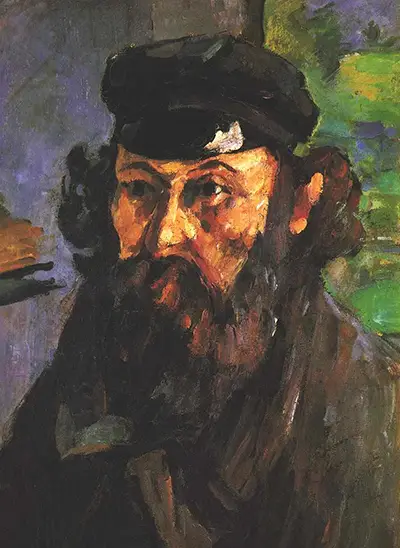Self-Portrait in a Casquette is from circa 1872 and captures the artist and model, Paul Cezanne, in his early thirties. It is clear even at this stage that he would age fairly quickly throughout his life and even here already looks like someone well into their middle ages.
He sports a cap with a peak that shines from light which appears from our right hand side. The item is better known as a Casquette. He stares off to our left hand side whilst his beard is at perhaps its largest and most ungroomed state that we would witness at any time in his life. Perhaps the young Cezanne was expressing himself to the fullest at this stage and throwing himself fully into the bohemian lifestyle that French artists would do at this time. His hair around his ears also grows long, curling over as it competes for space. His use of headwear even at this stage of his life was probably due to a thinning of his hair that would later leave only growth around the sides of his head. His thick coat worn here was very much a signature of his look throughout the artist's life.
Cezanne would sometimes work outdoors or in studios with little heating. The heavy coat could also protect his other clothing from paint and chemicals as well, just as others might wear overalls instead. He would continue to produce self portraits for the rest of his career and these together form a series of paintings that visually indicate his changing appearance over many decades. He continued to use the same facial expression throughout most of them, and often wore similar dark clothing. He would sport a beard throughout too, and looked very much the artist in angst that we are all familiar with. In this example, he does allow a small amount of the outdoors to appear in the background, albeit in detail which is deliberately kept to an absolute minimum, with undefined lines and more of a suggestion, or impression, of what lie outside.
This artwork can today be found at The State Hermitage Museum in St Petersburg, Russia. This stunning location features one of the finest collections of art in the world, with a strong focus on European and the best Russian art. They discuss about how this particular painting indicates the influence of Pissarro, making a comparison with one of his own self portraits that resides over in the Louvre in France. Cezanne was certainly more connected to the Impressionists at this stage of his lifetime although we can still see some details within paintings such as this which point to his own stylistic independence that would get stronger as his career developed over time. Visitors to the Hermitage will be astouned by the quantity and quality of the works on display here, many of which were donated by prominent Russian collectors over the last century or so.




